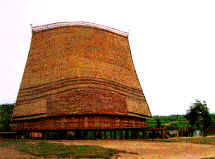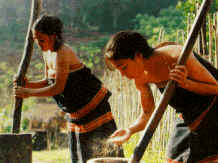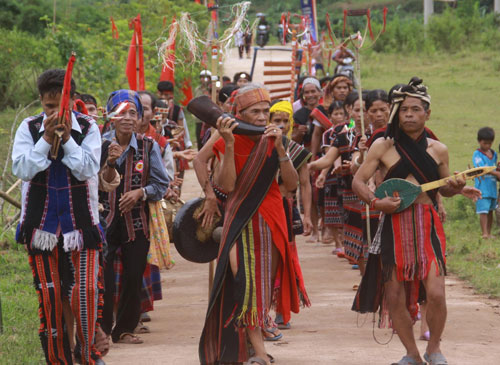With a population of nearly 97,000 persons, the Xo dang live in concentration in Kon Tum province and in scattered groups in the mountain areas of Quang Ngai and Quang Nam - Da Nang provinces. Their other names are Xo-dang, Ca-dong, To-dra, Ha-lang, Mo-nam, Ta-tri, Ka rang, Bri la and Con lan. Their language belongs to the Mon-Khmer Group.
The Xo-dang believe in animism and worship many spirits related to production and life.
They do farming mainly with the slash-and-burn method, The Mo-nam practice cultivation in submerged fields but to work the soil, they do not use ploughs and harrows but use buffaloes and men to trample it. Cattle and poultry raising, hunting, picking and gathering, fishing, basketry, weaving and blacksmithing are their common occupations. The To-dra are famous for the development of forgery using iron ore.
Each village has a rong (communal house) and a cemetery. Houses are clutched together. Mutual attachment and assistance prevails. The village chief is the most respected person, managing all village affairs and representing the villagers.
In some areas inhabited by the Xo dang, multi-generalion families live in elongated houses. Today, a nuclear family is always free to leave the extended one and set up a separate home. The name of a person is without a family name but the proper name consists of only one word with a prefix indicating sex-A for men. Y for women (for example A Nhung, YHen). Male and female adults, after having their teeth filed (now this custom is rarely observed are allowed to seek love. Wedding is simple. After wedding, the married couple live in rotation in each family in a few years. Cases of definitive settlement in one family are rare.
Among traditional ceremonies and festivities. the buffalo-stabbing rituals are held most vividly. The Xo dang like songs, dances, gong beating and old tales. Men not only have martial skills but also are good at architecture. sculpture and painting as expressed in the style of the communal house and the decorative pole at the buffalo-stabbing ceremony.
The communal house is remarkable for its roof with two steeply rising surfaces looking like huge sails or an axe-head pointing skyward, decorated with bird or animal horn motifs. It is built entirely with locally available trees and plants and assembled without the use of nails or wires.
The communal house is really an architectural work, a cultural product, a village premise and club.

_16-06-23.jpg)





